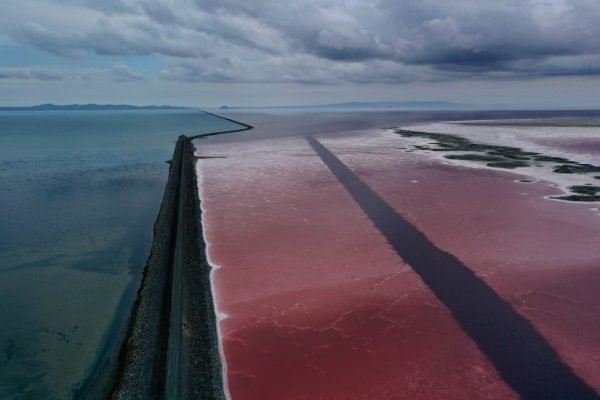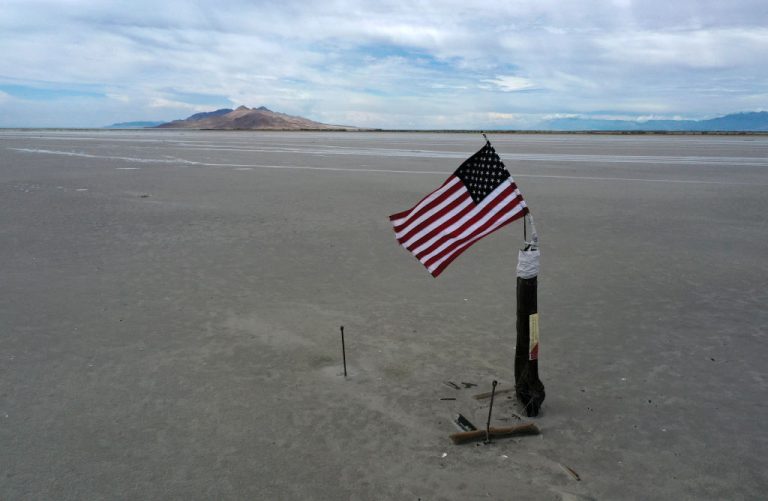As water levels in Utah’s Great Salt Lake continue to plummet, scientists are raising the alarm that not only will the scenario drive water scarcity for the surrounding regions but as water levels drop it could also leave a potentially deadly toxic dust bowl that could impact the health and well-being of millions of Americans.
Bonnie Baxter, director of the Great Salt Lake Institute at Westminster College in Salt Lake City Utah, told CNN, “This is an ecological disaster that will become a human health disaster. We know about dust storms, we know about particulate pollution, we know about heavy metals and how they’re bad for humans,” adding that, “We see a crisis that is imminent.”
Dubbed a “terminal lake,” the Great Salt Lake is the largest saltwater lake in the Western Hemisphere and the eight-largest terminal lake in the world. Located in the northern part of Utah next to the state’s capital Salt Lake City, the lake has a significant impact on local climate and supplies potable water to surrounding communities in part due to the lake-effect snow it creates.
The lake is fed by numerous rivers and from rain and melting snow from nearby mountains. However, water consumption upstream of the lake has grown significantly over the past decades, resulting in less and less water getting to the lake to replenish it.
READ MORE:
- Widespread Flooding Offers Little Relief for Drought-stricken California
- This Year’s Droughts Are Crushing the US Cotton Industry
- Toyota’s Chinese Factory Shutters Because of Drought-induced Electricity Shortage
Human consumption to blame not climate change
Stretching 75 miles long and with a width of 35 miles, the lake does not drain into any other bodies of water or system. Scientists estimate that water evaporating from the lake accounts for somewhere between 5 and 10 percent of the snowfall nearby mountains receive which provides freshwater for local communities and props up the region’s ski tourism.
Success
You are now signed up for our newsletter
Success
Check your email to complete sign up
Scientists don’t believe that climate change is a primary reason driving the plummeting water levels, instead blaming human overuse. Too much water is taken from the rivers and streams that feed the lake for domestic and agricultural consumption.
Americans and Canadians use an average of 80 gallons of freshwater per day per person, significantly higher than people in other developed countries.
While the communities dependent on the lake understand the problem, little has been done to curb water usage with some communities still requiring residents to keep their lawns green in the desert climate and, despite scarcity, water prices remain low.
Experts say that agriculture uses upwards of 75 percent of the water taken from the rivers that feed the lake, prompting warnings that if water usage is not cut by between 33 and 50 percent that the lake will disappear within five years.
The impact on surrounding communities should the lake disappear would be profound.
Some 2.5 million Americans can expect even warmer and drier temperatures, a decrease of five to 10 percent of mountain snow, less water coming from rivers and streams for cities and a drop in revenue from the region’s infamous ski resorts.
In addition, scientists believe that the loss of evaporation from the lake could trigger “abrupt crashes of lake industries, suppression of property values, mass migration, and social conflict associated with the loss of jobs, cultural identity, and quality of life.”
Toxic dust bowl
Perhaps most alarming is the toxic dust bowl that would be left behind should the lake disappear.
As water recedes the lake bed is exposed. The sediment of the lake bed contains arsenic, cadmium, mercury, nickel, chromium, lead, copper, selenium, organic contaminants, and cyanotoxins, which can be released into the surrounding areas as the lake bed dries.
Authors of a recent report titled, “Emergency measures needed to rescue Great Salt Lake from ongoing collapse,” wrote, “These pollutants can be transported by dust particles
smaller than 10 microns (1/5th the width of a hair). Particulate matter from dried lakebeds can increase rates of chronic and acute diseases associated with air pollution, including reproductive dysfunction, developmental defects, cognitive impairment, cardiovascular damage, and cancer.”
“Increased dust deposition in the watershed can also damage agricultural crops, degrade soil fertility, and cause premature snowmelt when deposited on snowpack,” the authors claim.

Ecological damage
The report says that the ecological damage as a result of the lake disappearing would be “extreme,” including the destruction of local food webs, an erosion of economic activity, and increased air pollution.
The lake is a habitat for 10 million migratory birds and fertilizer and brine shrimp from the lake feed millions of people worldwide.
“Our unsustainable water use is desiccating habitat, exposing toxic dust, and driving salinity to levels incompatible with the lake’s food webs,” the authors of the report argue, adding that, “The lake’s drop has accelerated since 2020, with an average deficit of 1.2 million acre-feet per year. If this loss rate continues, the lake as we know it is on track to disappear in five years.”
The scenario is not without precedent. California’s Owens Lake, which was drained by developers in the 1920s to build Los Angeles, resulted in clouds of fine, toxic dust which became known as “Keeler fog” after it forced the relocation of the residents of the town of Keeler.
Over one hundred years later residents are still footing the bill for the destruction.
A portion of every water bill paid in the region goes towards a dust mitigation program run by the Los Angeles Department of Water and Power. The Owens Lake fiasco has already cost upwards of $2.5 billion and continues to rise.
















